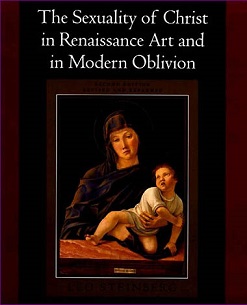Strange Bedfellows: Pope Francis and Leo Steinberg
Leo Steinberg (1920–2011) was an art historian whose focus extended from the Renaissance to the modern, and who left a critical legacy on several generations of scholars, critics, and artists. One of his classic works. The Sexuality of Christ in Renaissance Art and in Modern Oblivion, addressed the as-yet-unsuspected eroticism of the iconographies devoted to Christ and Mary, which generated much controversy throughout Steinberg’s career.
In a recent piece for the New Yorker’s Page-Turner blog, Lee Siegel uses Steinberg’s writing as a lens for understanding the correlation between Pope Francis’s embrace of gay Catholics and his devotion to the poor and afflicted. Here, Siegel notes a central tenet of Steinberg’s book, specifically that, “as a result of the rise of the Franciscan order, around 1260, an emphasis on Christ’s nakedness, and, thus, on his humanity, joined compassion to an acceptance of the role of sexuality in human life.”
Siegel points out that a Renaissance-era credo of the Franciscan order, from which Pope Francis takes his name, was nudus nudum Christum sequi (“follow naked the naked Christ”). He goes on to account for how Steinberg’s art historical thesis implies a theological premise imperative to positions taken by the current Pope on certain social and religious issues:
Pope Francis could well agree with Steinberg, who lamented that the human Christ disappeared “as modern Christianity distanced itself from its mythic roots; as the person of Jesus was refined into all doctrine and message, the kerygma of a Christianity without Christ.” That, Steinberg says, was when “the exposure of Christ’s genitalia became merely impudent.” One might add that in our own epoch the Catholic Church’s denial of Christ’s sexuality runs parallel to its denial of human sexuality, taboos that resurface in one scandal after another.
In modern times, the Catholic Church has been under siege to an unprecedented degree, as much by internal rifts and abuses as by unbelief and competing Protestant sects. In response, its doctrine and its message have become all the more abstract and inflexible; all the more a Christianity without Christ. The current Pope, by heeding the call to “follow naked the naked Christ,” seems determined to make inseparable the alliance between the naked body that lives, works, suffers, and dies, and the naked body that was created with the capacity to experience physical love.
As Siegel concludes, this would seem to indicate that Pope Francis has “an ally” in Leo Steinberg, whose argument for the crucial theology of the flesh positions an ultra-sensitive subject as an affirmation of a much larger kinship with the human condition.
To read more about The Sexuality of Christ in Renaissance Art and in Modern Oblivion, click here.
